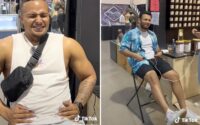New technologies to help the neurodiverse live better lives
When a teen in New Jersey went to the movies with his mother earlier this year, a simple night out turned into a nightmare when an irate manager called the police to have the young man removed from the theater.
The teen’s crime?
He’s autistic, nonverbal, and needed to accompany his mother to the women’s restroom.
It’s the type of scenario all too familiar for families who have children with autism and other developmental disabilities.
“It’s hard to put into words the feeling you get when somebody looks at your child like she’s ‘other,’” explains Bedford, NY, resident Wendy Belzberg, mother of a 25-year-old daughter with developmental disabilities named Leigh. “She sometimes does things that can be unexpected, but it doesn’t [justify] the lack of respect” people often show her.
So Belzberg decided to do something about it.
She’s the driving force behind Bedford’s Inclusive Initiative, an official community commitment to better accommodate residents with autism and other disabilities.
Launched this past fall, more than 60 stakeholders — from local government officials to first responders and shopkeepers — have already received specialized training on the tools and strategies that help the neurodiverse live rich and fully inclusive lives.
The initiative “benefits everyone,” says Belzberg. “We are all a little bit different. Who doesn’t need some accommodations or fine-tuning or consideration?”
Bedford joins a fast-growing list of municipalities, airports, amusement parks, and local businesses embracing neurodiversity initiatives.
Some work with education and training programs to become certified as autistic or sensory-friendly, including Philadelphia, which was just certified as the nation’s first-ever “sensory-inclusive city” by the non-profit organization KultureCity, while others are creating their programs to tackle specific challenges, including ways to make autistic drivers safer.
Even Walmart has gotten into the action, this year implementing sensory-friendly hours (think: no music and static TV walls) to accommodate those with sensory perception issues.
There’s a good reason for the growth in these initiatives: Autism diagnoses are skyrocketing.
In 2020, the last year for which data was available, 1 in 36 8-year-old children were identified with Autism Spectrum Disorder (ASD), up from 1 in 68 in 2012 and 1 in 150 in 2000, according to the Centers for Disease Control and Prevention (CDC).
Another report, published in 2022, suggests that roughly 1 in 100 children globally are diagnosed with ASD, an increase of nearly 40% from a similar 2012 report.
Additionally, nearly 1 in 11 kids were diagnosed with a developmental disability in 2021, up nearly 10% from 2019.
There is no one type of person with ASD.
Those on the spectrum range from gifted to intellectually disabled.
There are some common traits, however, such as difficulties with eye contact, sensory sensitivity, and stimming — which are repetitive self-soothing behaviors that can help those on the spectrum adapt to new or stressful environments.
These traits are often misinterpreted as someone not paying attention.
Those on the spectrum are often finely attuned to their surroundings and simply focused on details others might miss.
Temple Grandin, the renowned autistic academic and animal behaviorist — portrayed by Claire Danes in a 2010 biopic of the same name — has even named one of her books “Different … Not Less.”
However, such common fallacies can be dangerous for autistic individuals and others with disabilities, especially in interactions with first responders.
As a result, law enforcement agencies are introducing programs to train officers on how to interact with people with “invisible” disabilities, such as autism.
This past May, Mayor Adams signed legislation addressing just that.
A new focus is also on safety behind the wheel as states and municipalities consider ways to keep autistic drivers safer during traffic stops.
Connecticut, for instance, utilizes a “Blue Envelopes” program, as do several New Jersey counties.
The envelopes hold insurance cards and registration and identify the person as disabled.
It includes instructions for what police should expect (e.g., repetitive motions) and drivers (flashlights shone in their eyes).
These programs are not without their detractors, however, who worry the measures could increase discrimination and stigma.
Parental sweat often powers the most important changes in the disability community, as it has in Bedford as well as in Rhinebeck, NY, which in 2019 launched an Autism Supported Community.
But as the number of people with spectrum issues increases across society, the neurodiverse inclusivity movement is also being driven by the tourism industry
This was the case with High Point, NC, which this year was designated an Autism Certified Destination (CAD) by the International Board of Credentialing and Continuing Education Standards (IBCCES).
According to IBCCES president Meredith Tekin, CADs require a “representative sampling” of lodging, attractions, entertainment, and outdoor recreation to undertake training to address the needs of neurodivergent visitors.
Still, a parent is usually never far behind such efforts.
The High Point initiative, says Nancy Bowman, Vice President of Branding at Visit High Point, was put in motion by a local mother, Candace Humphrey, who has an autistic child and launched an inclusive gym, Q’s Corner, in 2020.
“It began attracting out-of-towners with neurodiverse children,” says Bowman, “and Candace reached out to our county commissioner to say, ‘These families are asking what else was there to do in High Point before going home.’”
Others certified through IBCCES include amusement parks such as Six Flags Great Adventure, Legoland (in New York and California), and Big Kahuna’s Water Park in New Jersey.
IBCCES has also recently partnered with the airport program Hidden Disabilities Sunflower, created to improve the travel experience of folks with invisible challenges.
Launched in England in 2016, it provides free sunflower necklaces to passengers discreetly indicating they might need additional support.
It now includes nearly 200 airports worldwide.
Meanwhile, airports themselves are increasingly accommodating the neurodiverse.
Pittsburgh International Airport, for instance, offers a dedicated sensory room to help people with ASD and other disabilities find refuge from sensory overload.
The embedding of structural design elements and learning tools to accommodate those with disabilities is not new.
However, anecdotal reports from specialty companies confirm an uptick in business since ASD diagnoses began to soar.
These designs are changing the look and feel of residential housing projects, public spaces such as libraries, entertainment venues, and, of course, classrooms.
Design guidelines vary, but many are similar to those in the Autism Design Index, which focuses on elements including acoustics (reducing echo and reverberation); spatial sequencing — “based on the tendency of autistic individuals to routing and predictability” — and having an “escape space” to provide respite from overstimulation.
But the most important element for success is to “work directly with people on the spectrum whenever possible during the design phase,” says Kim Steele, co-author with Sherry Ahrentzen of “At Home with Autism: Designing Housing for the Spectrum.”
Community integration is also key.
For instance, fencing, she explains, often required by law for developmental disability residencies, should not look fortress-like or institutional.
A focus on designing for those on the spectrum is behind Complete Playground, a new indoor play center in Manhattan’s FiDi neighborhood.
Set in a century-old one-time stock-exchange, the non-profit facility — which is intended for all children — has embedded various neurodiverse-friendly design elements throughout its infrastructure.
Founder Alex Reznik, who owns Complete Body gyms in Manhattan, has serious plans for the expansive 40,000 square-foot space — from structured classes for gymnastics, martial arts, and dance, to a café and occupational and speech therapy options.
While there will be no flashy arcades or loud music, there is a massive indoor playground, only this one comes with an attached, customizable multi-sensory environment called Snoezelen.
“Children with ASD will often have sensory processing challenges in public spaces,” says Alessandra Pucci, category account manager for the Snoezelen/Sensory Spaces at Specialist Schools, who worked with Reznik on the built environment. “The sensory room provides a place to self-regulate through sensory experience.”
Located just off the playground, the Snoezelen space features minimal visual clutter, soft gathering places, and a chair that uses low-frequency vibrations to induce relaxation.
Other elements include a tactile wall panel to induce various touch experiences and focal points, a bubble tube that helps kids relax, and special lighting (many autistic people are sensitive to bright lights).
Reznik believes the center must be for people of all abilities.
His eight-year-old autistic son, Milan, he says, was in his world until his conventional therapy was paired with inclusive activities.
It was then, Reznik says, that “he exploded out of his shell” and began to communicate.
Ultimately, whether out in the community, inside a classroom, or learning in a safe play center, inclusivity is key to an individual’s sense of belonging.
“If there isn’t an ethos of inclusion or education or acceptance of people who are different, my daughter won’t have friends or a community,” says Belzberg of the Inclusive Initiative. “And those things are what make us happy.”
Roberta Bernstein is the founder and editor of The Boost, a developmental disability website.


